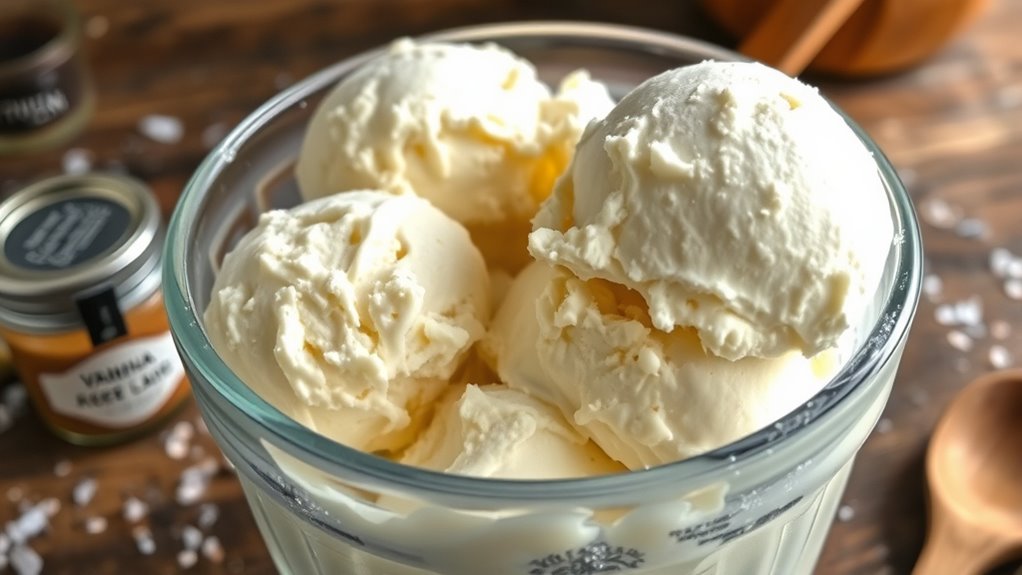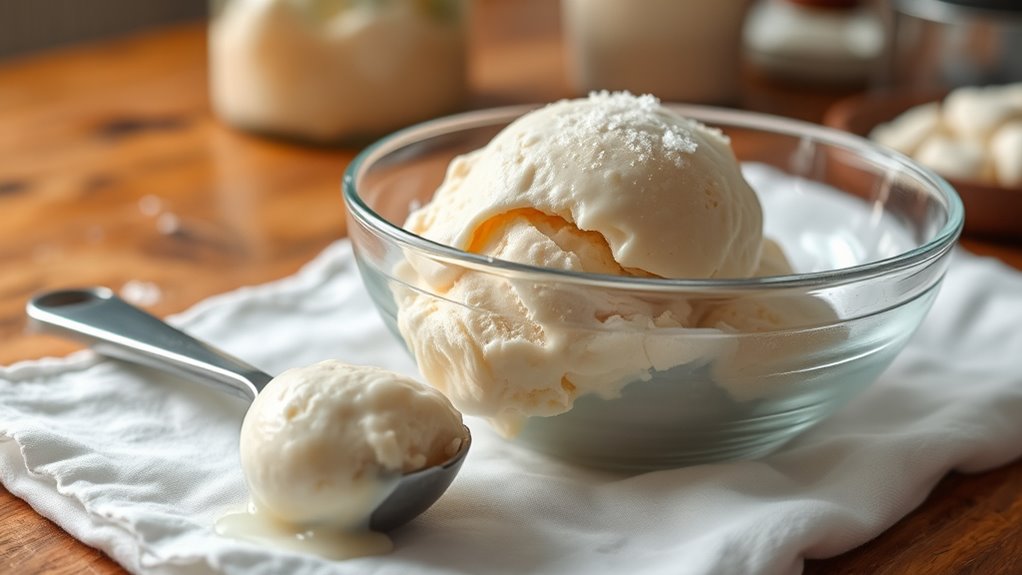Homemade ice cream can go bad or develop freezer burn if you don’t store it correctly. Use airtight, leak-proof containers made for freezing, and fill them as much as possible to limit air exposure. Keep your freezer at or below 0°F (-18°C) and avoid opening the door often, as temperature fluctuations can damage the texture. Proper storage extends its freshness, so if you want to know even more, there are simple tips to keep your ice cream at its best.
Key Takeaways
- Homemade ice cream can spoil or develop freezer burn if stored improperly or for too long.
- Use airtight, leak-proof containers to prevent odor absorption and moisture loss.
- Maintain a consistent freezer temperature at or below 0°F (-18°C) to preserve texture and flavor.
- Fluctuations in temperature accelerate spoilage and cause ice crystal formation.
- Proper wrapping and storage away from strong odors extend shelf life and keep ice cream fresh.

Storing homemade ice cream properly guarantees it stays fresh and maintains its creamy texture. The key to achieving this is selecting the right ice cream containers and managing your freezer temperature effectively. When it comes to containers, opt for airtight, leak-proof options made specifically for freezing. These containers help prevent ice crystals from forming and keep out any odors from other foods in your freezer. Silicone or plastic containers with tight-fitting lids are ideal, and if you’re using a traditional metal or glass container, ensure it has a secure seal. Filling the containers as much as possible also minimizes air exposure, which can lead to freezer burn and deterioration of your ice cream’s quality. Additionally, choosing proper storage containers designed for freezing can make a significant difference in preserving texture and flavor over time. Using containers with freezer-safe materials ensures optimal preservation without compromising the quality of your homemade ice cream. To further protect your homemade treat, consider wrapping the containers with plastic wrap or aluminum foil before sealing to add an extra layer of protection against air infiltration.
Maintaining the correct freezer temperature is equally important. Your freezer should be set at or below 0°F (-18°C) to keep homemade ice cream at its best. Temperatures above this can cause the ice cream to soften, develop ice crystals, and lose that smooth, creamy consistency you love. Consistency in your freezer’s temperature is crucial; frequent fluctuations can accelerate spoilage and compromise texture. If you have a freezer with a temperature control, check it regularly with a thermometer to ensure it stays within the ideal range. Avoid opening the freezer too often or leaving it open for extended periods, as this can raise the temperature temporarily and impact your ice cream’s quality. Proper storage conditions also help preserve the quality of frozen desserts, ensuring your homemade ice cream remains delicious and enjoyable for longer.
Frequently Asked Questions
How Long Does Homemade Ice Cream Stay Safe to Eat?
Homemade ice cream stays safe to eat for about 1 to 2 months, depending on how well you store it. To maintain ice cream freshness, keep it in an airtight container and confirm your freezer is at 0°F. The freezer lifespan of homemade ice cream varies, but for best taste and safety, consume it within this timeframe. Always check for freezer burn or off smells before enjoying it.
Can Homemade Ice Cream Be Refrozen After Thawing?
Think of ice cream refreezing like catching a falling star—you might catch it again, but it’s not the same. When you thaw homemade ice cream, it’s safest to avoid refreezing unless you’re sure it was thawed properly and kept cold. Thawing safety is key; if it’s been out too long or at room temperature, refreezing can cause bacteria growth. For best quality, only refreeze if it’s still cold and hasn’t been exposed to warm temperatures.
Does Homemade Ice Cream Develop Freezer Burn?
You might notice homemade ice cream develop freezer burn if it’s been stored too long or improperly. Freezer burn appears as dry, icy patches and affects texture and flavor. While it doesn’t necessarily mean spoilage, it’s a sign of quality decline. Check for spoilage signs like off smells or discoloration before consuming. To prevent freezer burn, store your ice cream in airtight containers and consume it within a few months.
How Can I Tell if Homemade Ice Cream Has Spoiled?
You can tell if your homemade ice cream has spoiled by checking its ice cream texture and flavor changes. If it feels overly icy, grainy, or develops ice crystals, those are signs it’s gone bad. Also, smell and taste are key—if it smells sour or has an off flavor, discard it. Fresh homemade ice cream should be smooth, creamy, and taste sweet without any strange aftertastes.
What’S the Best Container for Storing Homemade Ice Cream?
You should choose a sturdy, airtight container for storing your homemade ice cream. Opt for containers made of materials like plastic or metal that can prevent freezer burn and preserve your favorite ice cream flavors. Look for ones with tight-fitting lids to keep out moisture and odors. This guarantees your ice cream stays fresh, maintains its texture, and tastes just as delicious each time you enjoy it.
Conclusion
Remember, homemade ice cream can spoil if not stored properly, so always keep it airtight and consume within a few weeks. Freezing keeps it fresh, but don’t forget that “a stitch in time saves nine”—your best bet is to enjoy your treats promptly to savor their flavor and avoid waste. With proper storage, you’ll guarantee every scoop remains delicious, proving that a little care goes a long way in maintaining your homemade delights at their best.








